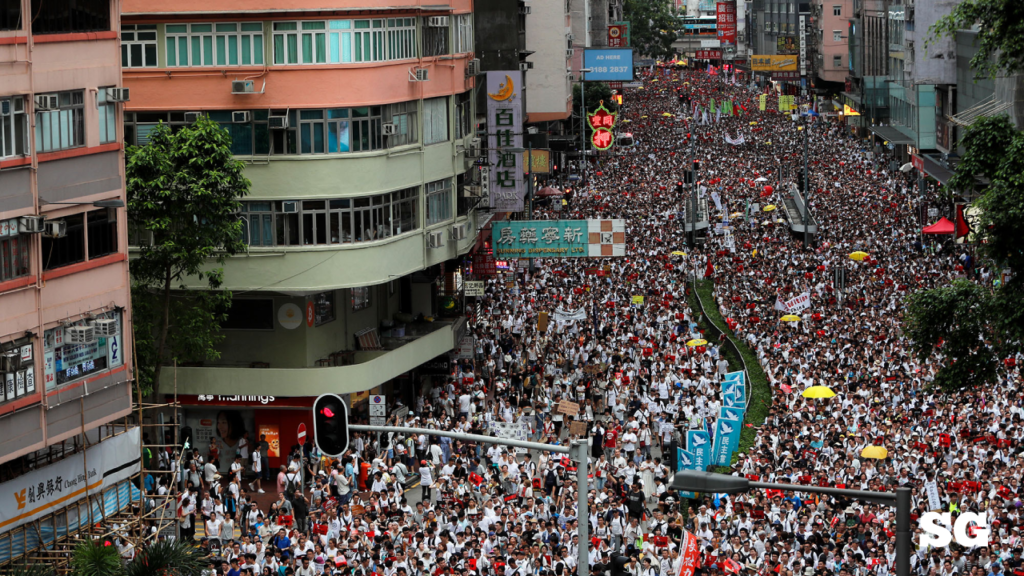Table of Contents

Timeline of Hong Kong Democratic Development and Crackdown
Early Promises of Autonomy and Democracy
December 1984
China and Britain sign the Joint Declaration. Hong Kong is promised a “One Country, Two Systems” model, ensuring a high degree of autonomy after the 1997 handover.
June 1989
Following Beijing’s Tiananmen Square crackdown, millions in Hong Kong march to demand democratic protections.
April 1990
China ratifies the Basic Law—Hong Kong’s mini-constitution—guaranteeing freedoms and pledging “universal suffrage” as a long-term goal.
1994
The Democratic Party is formed by merging two pro-democracy groups: the United Democrats of Hong Kong and Meeting Point.
September 1995
The Democratic Party wins 42% of the popular vote in legislative elections, becoming the largest party under British rule.
July 1997
Hong Kong officially returns to Chinese sovereignty.
Post-Handover Tensions and First Major Protests
July 2003
Over 500,000 people protest a proposed national security law (Article 23), leading to its withdrawal.
August 2014
China rules out open nominations for the 2017 Chief Executive election, triggering outrage.
September 2014
The “Occupy Central” civil disobedience movement begins. Protesters call for full democracy and block key areas for 79 days.
2019: The Year of Uprising
April 3, 2019
The Hong Kong government introduces an extradition bill allowing suspects to be sent to mainland China.
June 12, 2019
Massive protests erupt. Police use tear gas and rubber bullets. Demonstrations continue for months, escalating in intensity.
November 24, 2019
Pro-democracy candidates win 90% of seats in district council elections—seen as a strong rebuke to Beijing.
2020: National Security Law and Suppression Begins
June 30, 2020
China imposes a sweeping national security law criminalizing subversion, secession, terrorism, and foreign collusion.
July 11–12, 2020
More than 600,000 people participate in an unofficial pro-democracy primary election.
July 30, 2020
Twelve pro-democracy candidates are disqualified from the upcoming election.
July 31, 2020
The government postpones the September election, citing COVID-19 concerns.
November 11, 2020
Four opposition lawmakers are expelled from the legislature.
November 12, 2020
Fifteen remaining pro-democracy lawmakers resign in protest.
2021: Largest Crackdown to Date
January 6, 2021
Over 50 pro-democracy activists and former lawmakers are arrested under the national security law.
March 11, 2021
China overhauls Hong Kong’s electoral system, ensuring only “patriots” can run for office.
December 19, 2021
A “patriots-only” legislative election is held. Voter turnout hits a record low of 30.2%.
2023: End of Organized Political Opposition
May 27, 2023
The Civic Party, Hong Kong’s second-largest opposition group, votes to disband.
July 3, 2023
Police issue arrest warrants and offer HK$1 million bounties for eight overseas-based activists.
July 6, 2023
The legislature reduces the number of directly elected district council seats.
December 10, 2023
A district council election is held with no opposition participation. Turnout hits a new low.
2024–2025: Final Phase of the Crackdown
March 19, 2024
Lawmakers pass a new national security bill (Article 23), criminalizing treason, sedition, espionage, and foreign interference.
November 19, 2024
Forty-five pro-democracy activists are sentenced to up to 10 years for organizing the 2020 unofficial primary.
December 24, 2024
Authorities offer HK$1 million bounties for six more activists and revoke the passports of seven others.
February 20, 2025
The Democratic Party announces preparations to disband, marking the end of organized political opposition in Hong Kong.
“Timeline of Hong Kong Democratic Development and Crackdown” “Timeline of Hong Kong Democratic Development and Crackdown” “Timeline of Hong Kong Democratic Development and Crackdown” “Timeline of Hong Kong Democratic Development and Crackdown” “Timeline of Hong Kong Democratic Development and Crackdown”